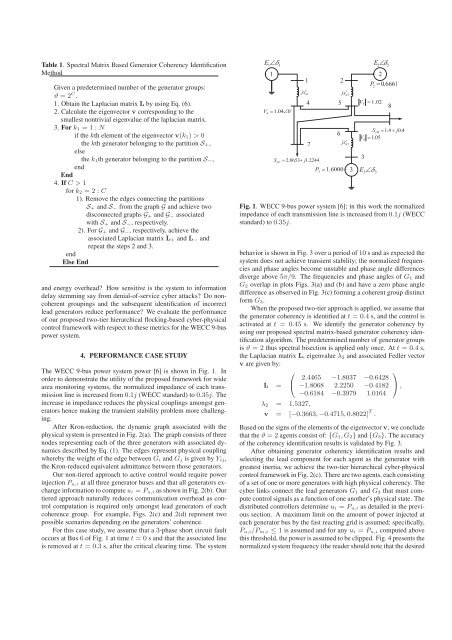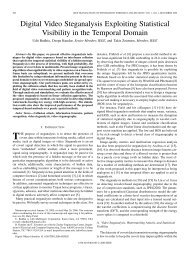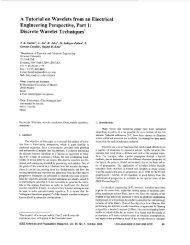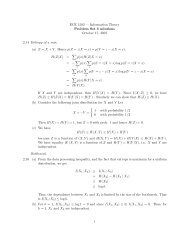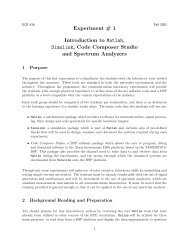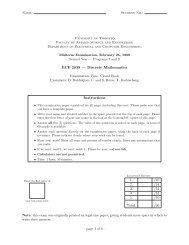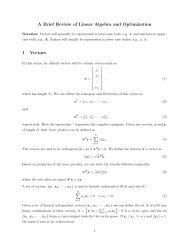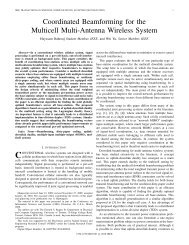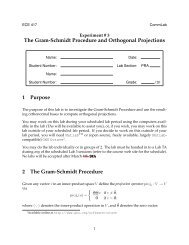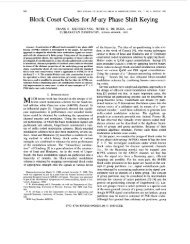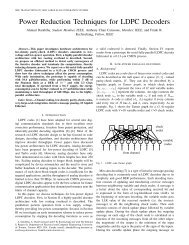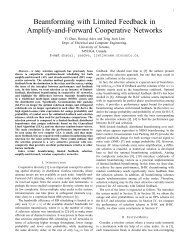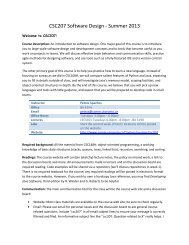On the use of cyber-physical hierarchy for - IEEE Xplore
On the use of cyber-physical hierarchy for - IEEE Xplore
On the use of cyber-physical hierarchy for - IEEE Xplore
You also want an ePaper? Increase the reach of your titles
YUMPU automatically turns print PDFs into web optimized ePapers that Google loves.
Table 1. Spectral Matrix Based Generator Coherency Identification<br />
Method<br />
Given a predetermined number <strong>of</strong> <strong>the</strong> generator groups:<br />
θ =2 C .<br />
1. Obtain <strong>the</strong> Laplacian matrix L by using Eq. (6).<br />
2. Calculate <strong>the</strong> eigenvector v corresponding to <strong>the</strong><br />
smallest nontrivial eigenvalue <strong>of</strong> <strong>the</strong> laplacian matrix.<br />
3. For k 1 =1:N<br />
if <strong>the</strong> kth element <strong>of</strong> <strong>the</strong> eigenvector v(k 1) > 0<br />
<strong>the</strong> kth generator belonging to <strong>the</strong> partition S +,<br />
else<br />
<strong>the</strong> k 1th generator belonging to <strong>the</strong> partition S −,<br />
end<br />
End<br />
4. If C>1<br />
<strong>for</strong> k 2 =2:C<br />
1). Remove <strong>the</strong> edges connecting <strong>the</strong> partitions<br />
S + and S − from <strong>the</strong> graph G and achieve two<br />
disconnected graphs G + and G − associated<br />
with S + and S −, respectively.<br />
2). For G + and G −, respectively, achieve <strong>the</strong><br />
associated Laplacian matrix L + and L − and<br />
repeat <strong>the</strong> steps 2 and 3.<br />
end<br />
Else End<br />
and energy overhead How sensitive is <strong>the</strong> system to in<strong>for</strong>mation<br />
delay stemming say from denial-<strong>of</strong>-service <strong>cyber</strong> attacks Do noncoherent<br />
groupings and <strong>the</strong> subsequent identification <strong>of</strong> incorrect<br />
lead generators reduce per<strong>for</strong>mance We evaluate <strong>the</strong> per<strong>for</strong>mance<br />
<strong>of</strong> our proposed two-tier hierarchical flocking-based <strong>cyber</strong>-<strong>physical</strong><br />
control framework with respect to <strong>the</strong>se metrics <strong>for</strong> <strong>the</strong> WECC 9-bus<br />
power system.<br />
4. PERFORMANCE CASE STUDY<br />
The WECC 9-bus power system power [6] is shown in Fig. 1. In<br />
order to demonstrate <strong>the</strong> utility <strong>of</strong> <strong>the</strong> proposed framework <strong>for</strong> wide<br />
area monitoring systems, <strong>the</strong> normalized impedance <strong>of</strong> each transmission<br />
line is increased from 0.1j (WECC standard) to 0.35j. The<br />
increase in impedance reduces <strong>the</strong> <strong>physical</strong> couplings amongst generators<br />
hence making <strong>the</strong> transient stability problem more challenging.<br />
After Kron-reduction, <strong>the</strong> dynamic graph associated with <strong>the</strong><br />
<strong>physical</strong> system is presented in Fig. 2(a). The graph consists <strong>of</strong> three<br />
nodes representing each <strong>of</strong> <strong>the</strong> three generators with associated dynamics<br />
described by Eq. (1). The edges represent <strong>physical</strong> coupling<br />
whereby <strong>the</strong> weight <strong>of</strong> <strong>the</strong> edge between G i and G j is given by Y ij,<br />
<strong>the</strong> Kron-reduced equivalent admittance between those generators.<br />
Our non-tiered approach to active control would require power<br />
injection P u,i at all three generator b<strong>use</strong>s and that all generators exchange<br />
in<strong>for</strong>mation to compute u i = P u,i asshowninFig.2(b).Our<br />
tiered approach naturally reduces communication overhead as control<br />
computation is required only amongst lead generators <strong>of</strong> each<br />
coherence group. For example, Figs. 2(c) and 2(d) represent two<br />
possible scenarios depending on <strong>the</strong> generators’ coherence.<br />
For this case study, we assume that a 3-phase short circuit fault<br />
occurs at Bus 6 <strong>of</strong> Fig. 1 at time t =0s and that <strong>the</strong> associated line<br />
is removed at t =0.3 s, after <strong>the</strong> critical clearing time. The system<br />
<br />
<br />
<br />
<br />
<br />
<br />
<br />
<br />
<br />
<br />
<br />
<br />
<br />
<br />
<br />
<br />
<br />
<br />
<br />
<br />
<br />
<br />
<br />
<br />
<br />
<br />
<br />
<br />
<br />
<br />
<br />
<br />
<br />
<br />
<br />
<br />
<br />
<br />
<br />
Fig. 1. WECC 9-bus power system [6]; in this work <strong>the</strong> normalized<br />
impedance <strong>of</strong> each transmission line is increased from 0.1j (WECC<br />
standard) to 0.35j.<br />
behavior is shown in Fig. 3 over a period <strong>of</strong> 10 s and as expected <strong>the</strong><br />
system does not achieve transient stability; <strong>the</strong> normalized frequencies<br />
and phase angles become unstable and phase angle differences<br />
diverge above 5π/9. The frequencies and phase angles <strong>of</strong> G 1 and<br />
G 2 overlap in plots Figs. 3(a) and (b) and have a zero phase angle<br />
difference as observed in Fig. 3(c) <strong>for</strong>ming a coherent group distinct<br />
<strong>for</strong>m G 3.<br />
When <strong>the</strong> proposed two-tier approach is applied, we assume that<br />
<strong>the</strong> generator coherency is identified at t =0.4 s, and <strong>the</strong> control is<br />
activated at t = 0.45 s. We identify <strong>the</strong> generator coherency by<br />
using our proposed spectral matrix-based generator coherency identification<br />
algorithm. The predetermined number <strong>of</strong> generator groups<br />
is θ =2thus spectral bisection is applied only once. At t =0.4 s,<br />
<strong>the</strong> Laplacian matrix L, eigenvalue λ 2 and associated Fedler vector<br />
v are given by:<br />
L =<br />
⎛<br />
⎝<br />
2.4465 −1.8037 −0.6428<br />
−1.8068 2.2250 −0.4182<br />
−0.6184 −0.3979 1.0164<br />
λ 2 = 1.5327,<br />
v = [−0.3663, −0.4715, 0.8022] T .<br />
⎞<br />
⎠ ,<br />
Based on <strong>the</strong> signs <strong>of</strong> <strong>the</strong> elements <strong>of</strong> <strong>the</strong> eigenvector v, we conclude<br />
that <strong>the</strong> θ =2agents consist <strong>of</strong>: {G 1,G 2} and {G 3}. The accuracy<br />
<strong>of</strong> <strong>the</strong> coherency identification results is validated by Fig. 3.<br />
After obtaining generator coherency identification results and<br />
selecting <strong>the</strong> lead component <strong>for</strong> each agent as <strong>the</strong> generator with<br />
greatest inertia, we achieve <strong>the</strong> two-tier hierarchical <strong>cyber</strong>-<strong>physical</strong><br />
control framework in Fig. 2(c). There are two agents, each consisting<br />
<strong>of</strong> a set <strong>of</strong> one or more generators with high <strong>physical</strong> coherency. The<br />
<strong>cyber</strong> links connect <strong>the</strong> lead generators G 1 and G 3 that must compute<br />
control signals as a function <strong>of</strong> one ano<strong>the</strong>r’s <strong>physical</strong> state. The<br />
distributed controllers determine u i = P u,i as detailed in <strong>the</strong> previous<br />
section. A maximum limit on <strong>the</strong> amount <strong>of</strong> power injected at<br />
each generator bus by <strong>the</strong> fast reacting grid is assumed; specifically,<br />
P u,i/P m,i ≤ 1 is assumed and <strong>for</strong> any u i = P u,i computed above<br />
this threshold, <strong>the</strong> power is assumed to be clipped. Fig. 4 presents <strong>the</strong><br />
normalized system frequency (<strong>the</strong> reader should note that <strong>the</strong> desired


